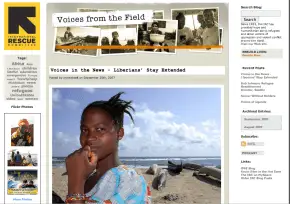An overview of blogging for development
Background As some of you might already know I work for GTZ (German Technical Cooperation), and I am of course very interested in the potential of the web towards development aid and international cooperation. Surprisingly--and correct me if I am wrong!--but to me, it seems there are not many blogs out their in this field yet. There are of course a lot of portals --and two of the big ones are the development gateway or eldis.org. However, in my opinion, the development sector has yet not grasped the potential of web2.0. I already argued in a post that the result is that this shift, so far, is challenging traditional development agencies.
What is there in the world wide web? One interesting website is aid worker network, which contains personal blogs from all around the world. There are also individual blogs that describe in an authentic and provoking way how it is to work in this field. Check out these examples from Afghanistan and Sudan. The science world is also blogging, and such is the case of Oversea Development Institute or professors such as Dan Rodrik for international political economy, or John Daly for knowledge for development. But once again, I am surprised that for such an international topic, blogs are not used in a wider scale. For example, why aren't there any more professors having blogs? And why so few development organizations offer blogs? Some organisations in this field have started experimenting with it (Worldbank) or using it as a first step internally (GTZ, UN etc.).
 Blogs for storytelling
As blogs can have different purposes and styles of expression, in the humanitarian relief field, they seem to be quite successfully used. The Guardian issued an interesting article (not online available) a few weeks ago, which highlights the potential for blogs and how organisations such as Oxfam or the International Rescue Comittee (IRC) use them as an strategic communication tool. Other examples are "Voices from the field", representing the work from IRC and impressions from all around the world; and Ian Bray from Oxfam blogging for BBC about the recent flood in India.
Blogs for storytelling
As blogs can have different purposes and styles of expression, in the humanitarian relief field, they seem to be quite successfully used. The Guardian issued an interesting article (not online available) a few weeks ago, which highlights the potential for blogs and how organisations such as Oxfam or the International Rescue Comittee (IRC) use them as an strategic communication tool. Other examples are "Voices from the field", representing the work from IRC and impressions from all around the world; and Ian Bray from Oxfam blogging for BBC about the recent flood in India.
In old times, it took weeks to get information form disasters into the global media and "now we can get blogs or photos up in just hours, which are able to get voices of ordinary people heard by a potential audiences of millions and can really press home the desperation and emergency situation happening on the ground." So, in a way donors can read from the beneficiaries about what has happened to their money. The article continues, especially the Tsunami "revolutionised the aid world's use of digital media", being it the above described as different communication or the direct funding over the web. Blogging itself opens new fast ways of coverage, but even more importantly, an individual perspective from persons concerned.
The difference technology made The economist argues in a recent article, "technology is transforming humanitarian relief—and shifting the balance of power between donors and recipients." The article describes how Internet and mobile phones offer new instruments to coordinate more efficiently disaster relief. Relief Web is a portal to coordinate these efforts. It describes also that communication is not a one way street, through more cheaply available technology such as mobile phones, also small NGOs or even individuals can engage. So, “technology completely alters the way humanitarian work is done." “In the humanitarian operation of the future,” says Save the Children's Mr Porter, “beneficiaries of emergency aid will use technology to tell us what they need—cash, food, or education—find out from us what to expect, and track its arrival, just as we can track an order from Amazon.com now.”